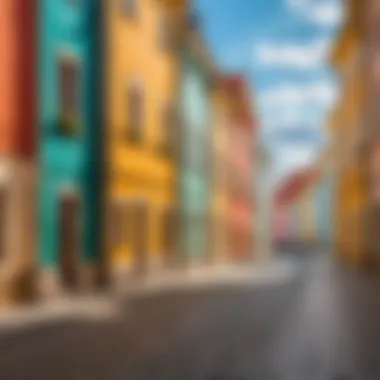Exploring Lithuania: A Comprehensive Travel Guide


Intro
Lithuania, a jewel of the Baltic region, offers a rich blend of history, culture, and nature. This guide aims to illuminate the unique aspects of this fascinating country. Whether you are a seasoned traveler or a novice explorer, Lithuania is poised to captivate you with its diverse offerings.
The journey begins in its vibrant cities, each rich in history and charm. From UNESCO World Heritage sites in Vilnius to the coastal beauty of Klaipėda, you will find plenty to discover.
In addition to urban exploration, Lithuania's natural landscapes are equally enchanting. Picturesque lakes, vast forests, and serene coastal areas provide a perfect backdrop for relaxation and adventure.
This article will cover key aspects of Lithuanian life: its cultural heritage, traditional cuisine, and festivals. We will also provide essential travel tips to help you navigate this beautiful country, ensuring a rich and fulfilling experience.
"Discovering Lithuania is not just about sights; it’s about immersing yourself in the local traditions and lifestyles."
Популярные направления
When envisioning Lithuania, travelers may not realize the range of destinations available. Exploring less common locales enhances the experience and showcases Lithuania's hidden treasures.
Уникальные направления для э�кзотических путешествий
- Nida – A stunning resort on the Curonian Spit, known for its sand dunes and tranquil beaches.
- Trakai – Home to the striking Trakai Castle, surrounded by lakes, perfect for a day trip.
- Žemaitija National Park – A natural reserve with lush forests and diverse wildlife, ideal for hiking.
Комфортные места для семейного отдыха
Lithuania is also a family-friendly destination. Places perfect for family visits include:
- Vilnius Zoo – Offers an engaging day for both kids and adults.
- Palanga – A coastal town known for its sandy beaches and amusement parks, ensuring fun for everyone.
- Klaipėda Sea Museum – Educational and entertaining, showcasing marine life and history.
Подготовка к путешествию
Planning a trip requires careful thought. Here are important tips to help you prepare.
Советы по выбору маршрута
- Research destinations that match your interests.
- Consider travel times and local transport options.
- Balance urban and natural areas for a varied experience.
Как собрать чемодан: полезные советы
Packing effectively can enhance your travel experience:
- Choose versatile clothing suitable for varying weather.
- Don’t forget essentials like chargers, maps, and travel documents.
- Leave space for souvenirs, which are abundant in Lithuania.
This guide serves as your companion as you explore Lithuania’s myriad offerings. Understanding its rich cultural fabric, natural beauty, and practical travel tips will ensure a memorable adventure.
Prologue to Lithuania
The introduction to Lithuania sets the stage for understanding this Baltic nation. It highlights the significant cultural and historical elements that shape Lithuania's identity. This section provides the essential context that enhances the reader's understanding of subsequent topics in the article. Moreover, it emphasizes the relevance of Lithuania as a travel destination, showcasing its unique characteristics and experiences that await visitors.
Geographical Overview
Lithuania, located in Northeastern Europe, is bordered by Latvia to the north, Belarus to the east and south, Poland to the south, and the Baltic Sea to the west. The country covers an area of around 65,300 square kilometers. Notably, it features a flat terrain with plains, hills, and low-lying areas, making it suitable for agriculture. Lithuania's coastal region includes the Curonian Spit, a UNESCO World Heritage Site known for its unique sand dunes and diverse wildlife.
The climate in Lithuania is primarily temperate, with cold winters and warm summers. The landscape is dotted with many rivers and lakes, including the famous Nemunas River and the striking Visaginas Lake. Understanding the geographical context enriches the travel experience, providing insights into the natural beauty found within Lithuania's borders.
Historical Context
Lithuania has a rich and intricate history, shaped by various influences over the centuries. Its journey began in the 13th century when it became a significant power in the region, establishing the Grand Duchy of Lithuania, which stretched from the Baltic to the Black Sea. This period is marked by cultural and political strength, where the Lithuanian language and traditions flourished.
The 18th and 19th centuries brought challenges, including partitions and periods of foreign control. Lithuania declared independence in 1918 but faced occupation during World War II. The country regained its independence in 1990 after a peaceful movement that resonated throughout the region.
Today, Lithuania is a member of the European Union and NATO, reflecting its modern identity while honoring its complex past. Recognizing this historical context is crucial for travelers, as it informs the societal norms, cultural practices, and national pride found within the country.
Cultural Heritage
Lithuania's cultural heritage is a tapestry interwoven with history, language, art, and traditions. This section is essential as it encapsulates the essence of Lithuanian identity. Recognizing the importance of cultural heritage in Lithuania helps in understanding how these elements shape the country's character and contemporary society. Preserving traditions, promoting local languages, and advancing art forms contribute to a vibrant cultural scene that continues to evolve while paying homage to its roots.
Language and Literature


Lithuanian is one of the oldest languages in Europe, belonging to the Baltic language group. It holds a unique place in the world of linguistics, retaining many archaic features lost in other Indo-European languages. Reading Lithuanian literature offers a window into the soul of the nation. Notable authors like Maironis and Romain Gary have drawn from the rich history and struggles of Lithuania, creating works that resonate on multiple levels. The rise of contemporary writers continues to enhance the literary landscape, reflecting modern themes while preserving traditional narratives.
Traditional Music and Dance
Lithuania possesses a rich tradition of music and dance that has survived through epochs of change. Folk music is characterized by its use of the kanklės, a string instrument akin to a zither, and vocal harmonies that tell stories of daily life, nature, and folklore.
Dance is not merely entertainment; it is an integral part of social rituals and celebrations. Traditional dances often involve intricate steps and colorful costumes, showcasing the community’s pride and connection to history. Events and festivals frequently feature these cultural expressions, giving both locals and visitors an opportunity to engage with Lithuania’s vibrant heritage.
Art and Architecture
Lithuanian art is a reflection of the diverse historical influences that have shaped the nation. From medieval religious art in churches to modern installations, the evolution of visual arts is noteworthy.
Architecture in Lithuania ranges from Gothic and Baroque styles found in Vilnius to Soviet-era concrete structures. The juxtaposition of old and new creates a unique urban landscape. Important landmarks like the Cathedral Square and the Gates of Dawn serve as reminders of Lithuania's complex past. Every visit to these sites unveils layers of history and charm, inviting reflection on the influences that have formed the nation.
"Cultural heritage bridges the past and present. It is essential for future generations to appreciate and continue the legacy."
Understanding the cultural heritage of Lithuania is not just an academic exercise; it enriches the travel experience. Appreciating language, music, dance, and art fosters a deeper connection to the nation's soul. As visitors explore Lithuania, they engage with the very fabric of its history, gaining insights that transcend mere sightseeing.
Major Cities in Lithuania
Lithuania's major cities are not only central to its economy but also rich in history and culture. Each city offers a unique perspective on Lithuanian life and traditions, making them essential destinations for any traveler. Understanding the specifics of these cities enhances the overall experience of exploring Lithuania, as they serve as cultural hubs with numerous attractions.
Vilnius
Historical Significance
Vilnius, the capital city, has a deep historical significance that reflects the nation's past and development. It was once a key center of the Grand Duchy of Lithuania and retains many historical sites that showcase its evolution over centuries. The Old Town, a UNESCO World Heritage site, is notable for its Baroque architecture and historical landmarks like the Gediminas Tower. This historical context is crucial as it marks the evolution of Lithuanian identity and statehood.
The unique feature of Vilnius's history is its blend of influences from various cultures, including Polish and Jewish. This makes it a fascinating place for visitors interested in historical narratives. The impact of various occupations on the city’s development can also be seen in the architecture and urban layout, offering great advantages for those seeking a diverse historical experience.
Modern Attractions
Vilnius also does not fall short on modern attractions. In contrast to its rich history, the city has a lively contemporary atmosphere with numerous cafes, shops, and art spaces. Places like the Contemporary Art Centre illustrate the vibrant art scene, attracting both locals and tourists. The modern architecture juxtaposed against historical buildings creates an interesting visual contrast and provides ample opportunities for photography.
Moreover, Vilnius's recreational spaces, such as Bernardine Gardens, offer locals and visitors a place to relax amidst bustling city life. The modern aspects of Vilnius add a layer of depth to its historical foundations, making it a balanced destination for diverse interests.
Kaunas
Cultural Landmarks
Kaunas stands out for its rich cultural landmarks. The city is known for its interwar architecture, particularly evident in the Art Deco styles that dominate the area. Landmarks like the Kaunas Castle and the Town Hall add to the city's historical narrative, revealing the growth of Lithuania during a critical period.
The city’s unique feature is its recognition as a European Capital of Culture, which showcases its commitment to cultural exchange and heritage. This emphasis on culture enriches the visitor experience significantly, as many events and exhibitions are hosted throughout the year.
Local Cuisine
Local cuisine in Kaunas is a significant aspect of its cultural identity. Traditional dishes such as Kibinai reflect the city’s culinary heritage and offer visitors an authentic taste of Lithuanian culture. Restaurants emphasize using local ingredients, providing a fresher and more authentic culinary experience.
The unique feature of local cuisine is its variety, from street food to fine dining, catering to all tastes and preferences. This allows travelers to engage with Lithuanian culture through food, making it a popular choice for visitors looking for an immersive experience.
Klaipeda
Port City Features
Klaipeda is Lithuania's only port city, offering essential insights into maritime culture and economic activities. The city's location on the Baltic Sea has made it a crucial trade center for centuries. The Klaipeda Seaport is a significant aspect for travelers interested in trade history and economic ties of the region. The seaport’s operations and the presence of various vessels highlight its importance as a gateway to the Baltic region.
An interesting feature of Klaipeda is its unique Curonian Spit, a UNESCO World Heritage site that draws nature enthusiasts and offers stunning landscapes. This emphasis on natural beauty is both a charming and advantageous aspect of visiting Klaipeda.
Natural Wonders
Klaipeda also serves as a hub for exploring natural wonders. The nearby Curonian Lagoon and the expansive sand dunes provide excellent opportunities for outdoor activities. Visitors can enjoy hiking, birdwatching, or simply soaking in the picturesque surroundings.
The ability to access both urban and natural environments is a compelling characteristic of Klaipeda. This duality allows for diverse experiences, making Klaipeda an attractive choice for travelers seeking both city life and nature.
Natural Landscapes


The natural landscapes of Lithuania serve as a significant attraction for both local and international visitors. They highlight the diverse ecological characteristics found within the country. This aspect of Lithuania reflects its rich biodiversity and offers various outdoor activities that can be enjoyed by travelers. The landscapes are not just visually appealing but also serve educational purposes, showcasing the importance of conservation efforts.
Lithuania is home to numerous national parks, lakes, and rivers, each contributing uniquely to the tourism experience. Exploring these natural features allows visitors to appreciate the serene environment and engage with outdoor adventures. Activities like hiking, fishing, and birdwatching are popular, allowing tourists to experience the natural beauty up close.
National Parks
Lithuania boasts several national parks that exemplify its commitment to preserving nature. They offer an escape from urban life and provide a window into the ecosystems that make this region unique. The two most notable national parks are Aukštaitija National Park and Žemaitija National Park, both of which offer distinct experiences.
Aukštaitija National Park
Aukštaitija National Park is known for its stunning lakes and dense forests. Spanning over 40,000 hectares, it is the largest national park in Lithuania. The park’s key characteristic is its extensive network of water bodies, which includes around 126 lakes.
This park is a beneficial choice for nature enthusiasts. It provides opportunities for hiking, scenic boat rides, and fishing, making it a popular destination for those who enjoy outdoor activities. The unique feature of Aukštaitija is its tranquil atmosphere, allowing visitors to unwind and connect with nature. However, one should note that during peak tourist seasons, the park can become crowded, which might detract from the experience.
Žemaitija National Park
Žemaitija National Park offers visitors a blend of lush forests and cultural heritage sites, making it distinct from Aukštaitija. This park is known for its rolling hills and traditional wooden architecture. Its key characteristic is the various cultural landmarks found throughout the area, such as ancient burial mounds and well-preserved villages.
This park is seen as a popular destination for those looking to immerse themselves in both nature and history. The unique feature of Žemaitija is its rich cultural trails, which allow visitors to explore both natural and human history. A downside to consider is the fewer accommodation options, which may require planning ahead for travelers.
Lakes and Rivers
The lakes and rivers in Lithuania contribute significantly to the country's landscape. They not only enhance the natural beauty but also support local ecosystems and provide vital resources for recreation and tourism. Two key features in this regard are Visaginas Lake and the Nemunas River.
Visaginas Lake
Visaginas Lake is an artificial reservoir created in the 1970s, primarily for the needs of the nearby nuclear power plant. The key characteristic of this lake is its well-maintained surroundings, which have become an attractive spot for visitors seeking leisure activities like swimming and boating. The lake serves as a beneficial choice for family-friendly outings as well as quiet locales for relaxation. One unique feature of Visaginas Lake is the scenic views of the surrounding forests. However, the lake can sometimes feel less natural, which may not appeal to everyone looking for pristine natural settings.
Nemunas River
The Nemunas River is the longest river in Lithuania and flows through many significant towns. It is known for its beautiful landscapes and supporting diverse wildlife. The river's key characteristic is its flowing course, which provides opportunities for various water activities including kayaking, which attracts many adventure seekers.
The river is a popular choice for scenic boat tours, showcasing the natural beauty of the countryside. The unique feature of the Nemunas River lies in its ecological importance, acting as a habitat for a range of species. A potential disadvantage is the river’s fluctuating water levels, which may affect boat access during certain times of the year.
Exploring Lithuania's natural landscapes reveals a multifaceted beauty that complements its cultural heritage. Understanding and experiencing these features deepens the appreciation for this Baltic nation.
Lithuanian Cuisine
Lithuanian cuisine is a vital aspect when exploring the culture and traditions of this Baltic nation. Food plays a significant role in daily life and reflects historical influences and local ingredients. Knowing about Lithuanian cuisine can enhance your travel experience by providing insight into local customs and flavors. It helps travelers connect with the people and the land.
Traditional Dishes
Cepelinai
Cepelinai are perhaps the most famous traditional dish in Lithuania. These large dumplings are made from grated and boiled potatoes. They are typically filled with ground meat and served with a rich sour cream sauce. The key characteristic of cepelinai is their size and the hearty ingredients. They represent comfort food for many locals. This dish is a beneficial inclusion in the article, as it symbolizes the local agricultural practices and culinary heritage. The unique feature of cepelinai is that they are often served on special occasions and family gatherings.
However, cepelinai can be quite filling, which might not appeal to every traveler, especially those seeking lighter fare. Regardless, they offer a taste of Lithuanian culture that is not to be missed.
Šaltibarščiai
Šaltibarščiai is a vibrant cold beet soup that showcases Lithuania's love for fresh produce. This dish stands out due to its bright pink color and refreshing taste. It typically contains beets, kefir, cucumbers, and dill. The key characteristic of šaltibarščiai is its cool, tangy flavor, making it particularly enjoyable during the summer months. This soup is a popular choice because it highlights the use of local ingredients and is an example of seasonal cooking.
The unique feature of šaltibarščiai is its health benefits. It is low in calories and packed with vitamins. For those looking for lighter options, this dish is an excellent recommendation. However, not everyone may appreciate the sour taste of kefir, which could limit its appeal to some travelers.
Local Ingredients
Local ingredients in Lithuanian cuisine heavily influence the traditional dishes. The country’s rich soil and favorable climate allow for the cultivation of various fruits and vegetables. Commonly used ingredients include potatoes, beets, rye, and fresh herbs. These ingredients are not only integral to traditional dishes but also highlight the importance of sustainability and supporting local farmers. Understanding local ingredients gives travelers insight into the agricultural practices that shape the culinary landscape in Lithuania.
Knowing about local products can deepen a traveler's appreciation for a country’s culture and history.
Festivals and Events
Festivals and events form an essential part of Lithuanian culture, reflecting the nation's rich heritage and community spirit. They serve multiple purposes—promoting tourism, celebrating traditions, and encouraging cultural exchange. Participating in one of these events offers a window into the daily lives of the Lithuanian people and their values. Travelers experience the warmth of local hospitality and witness the fusion of old and new customs.
Moreover, festivals often highlight significant historical and cultural narratives, allowing for personal connections to the past. Festivals contribute to the local economy and strengthen community ties, fostering a sense of unity among participants. Thus, engaging in these celebratory events is not just enjoyable but also insightful, making them a pivotal aspect of visiting Lithuania.


Cultural Festivals
Cultural festivals in Lithuania are vibrant manifestations of its artistic expressions. They celebrate music, dance, and visual arts, capturing the essence of Lithuanian identity.
The Vilnius Festival
The Vilnius Festival is a notable cultural event that showcases a diverse array of performances, including opera, ballet, and contemporary music. It attracts local and international artists, making it a prominent part of Lithuania's cultural calendar. The festival's key characteristic is its commitment to high-quality artistry, often featuring renowned performers and innovative productions. This aspect makes it a beneficial choice for visitors interested in immersing themselves in the local arts scene.
A unique feature of the Vilnius Festival is its ability to blend various artistic styles, reflecting contemporary trends while honoring traditional forms. However, the festival can be crowded, and securing tickets might require advance planning, so visitors should consider this when making their travel itineraries.
The Kaunas Jazz Festival
The Kaunas Jazz Festival is another significant event that celebrates the vibrancy of jazz music in Lithuania. This festival not only features local talents but also invites international jazz musicians, creating a rich tapestry of musical expressions. The festival is known for its committed focus on promoting jazz as a form of cultural dialogue, making it an exciting choice for those who are passionate about music.
A standout feature of the Kaunas Jazz Festival is its outdoor performances, allowing attendees to enjoy live music in picturesque settings across Kaunas. This enhances the atmosphere and encourages spontaneous interactions among participants. However, some visitors might find particular performances less accessible due to ticket pricing, making it wise to research the lineup and plan accordingly.
Historical Reenactments
Historical reenactments provide a tangible connection to Lithuania's past. These events recreate significant historical moments, allowing attendees to experience history firsthand. They often involve elaborate costumes and authentic settings, immersing participants in a unique blend of education and entertainment. Festivals centered around historical events foster a deeper understanding of Lithuania's cultural evolution and provide immersive experiences that enrich the visitor's journey.
Traveling in Lithuania
Traveling in Lithuania is a vital aspect of understanding this Baltic nation. The way you navigate the country directly affects the overall experience. Efficient transportation and comfortable accommodation can enhance your enjoyment, making it essential to explore this topic thoroughly. Travelers can discover the rich culture, historical landmarks, and natural beauty of Lithuania with the right planning and insights.
Transportation Options
Public Transport
Lithuania boasts a robust public transport system. This system includes buses and trains that connect major cities and towns. The public transport is known for its affordability and accessibility. It serves as a beneficial choice for budget travelers, allowing them to explore without overspending.
A unique feature is the extensive network of buses that operate in Vilnius, Kaunas, and Klaipeda. These buses run frequently, making it easy to get around. Moreover, the ticketing system is user-friendly, often allowing multiple stops with a single fare. However, some disadvantages include limited service during late-night hours and occasional overcrowding, particularly on popular routes.
Car Rentals
For travelers wanting flexibility, car rentals are an excellent option in Lithuania. Renting a car provides the freedom to explore less accessible areas and scenic routes at your own pace. Many rental companies operate, offering a variety of vehicles to suit different preferences.
One key characteristic of car rentals is the straightforward process to obtain a vehicle. Many agencies are located in airports and city centers. This makes picking up a car easy for incoming travelers. However, the major drawback of having a rental car is parking, especially in busy urban areas. Finding a spot can sometimes be a challenge, and costs may add up depending on location.
Accommodation Choices
Hotels
Hotels in Lithuania vary in size and style, accommodating diverse preferences. They are typically found in urban areas, providing comfort and amenities. A strong characteristic of Lithuanian hotels is the quality of service and hospitality provided. Many hotels offer breakfast and local guidance, enhancing overall travel experiences.
One unique feature is that some hotels are housed in historical buildings, merging modern comfort with a touch of history. However, prices can vary significantly based on location and season. It is recommended to book in advance during peak times to secure good rates.
Hostels
For more budget-conscious travelers, hostels present a popular option. These accommodations are known for their communal environment, allowing travelers to meet and connect. Many hostels offer dormitory-style rooms alongside private ones, catering to different needs.
A notable advantage of choosing a hostel is the affordability and the social atmosphere they provide. Most hostels also organize activities, allowing guests to explore the city together. However, the trade-off can be less privacy and noise, which might not suit everyone, especially those seeking tranquility after a long day of sightseeing.
Always consider your travel needs and budget when choosing transport and accommodation in Lithuania. The right decisions can greatly impact your journey.
Closure
The conclusion serves as an essential component in this guide to Lithuania, encapsulating the key insights discussed in previous sections while reinforcing the value of travel to this Baltic nation. It is not merely a summary but a reflective ode to the multifaceted experiences awaiting visitors.
Final Thoughts on Visiting Lithuania
Visiting Lithuania offers a unique opportunity to immerse oneself in its rich history, culturally vibrant cities, and stunning natural landscapes. From the historic city of Vilnius, with its baroque architecture and cafes, to the serene expanses of Aukštaitija National Park, the country unfolds layers of experiences.
Lithuania's cuisine is another inviting feature. Traditional dishes like Cepelinai and Šaltibarščiai reveal a culinary heritage that is both hearty and delightful. Exploring the local food scene can provide insights into the nation's agricultural roots and regional variations.
Cultural festivals, such as The Vilnius Festival and The Kaunas Jazz Festival, showcase the country's artistic flair and communal celebrations. Engaging in these experiences enriches the visit exponentially.
Considerations for travel to Lithuania should include planning according to the seasons. Each season offers distinct experiences, from summer festivals to winter markets. Public transport is efficient, making it easy to navigate between cities. A range of accommodations from hotels to hostels provides visitors with versatile choices depending on their preferences.
In essence, Lithuania is a land where history meets modernity, where natural beauty coexists with cultural wealth. The journey through this country invariably leads to valuable discoveries, ensuring that every traveler leaves with memories etched in their minds.
Lithuania waits to unlock its secrets. It is not just a place to visit; it is a journey into the heart of a unique heritage.







